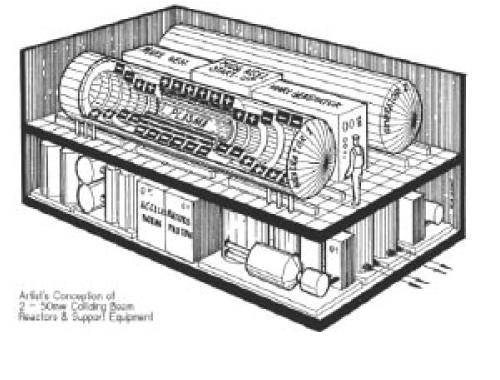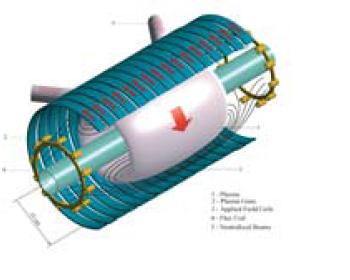I have dug up the details on this privately well funded fusion project as well as a related project with somewhat similar goals in terms of the size of intended reactors. I remember the old Migma project being described in OMNI magazine. The goal was cheap, relatively small stackable fusion reactors.
Some background information from wikipedia on aneutronic fusion
Aneutronic fusion is any form of fusion power where no more than 1% of the total energy released is carried by neutrons. Since the most-studied fusion reactions release up to 80% of their energy in neutrons, successful aneutronic fusion would greatly reduce problems associated with neutron radiation such as ionizing damage, neutron activation, and requirements for biological shielding, remote handling, and safety issues. Some proponents also see a potential for dramatic cost reductions by converting the energy of the charged fusion products directly to electricity. The conditions required to harness aneutronic fusion are much more extreme than those required for the conventional deuterium-tritium (DT) fuel cycle, and even these conditions have not yet been produced experimentally. Even if aneutronic fusion is one day shown to be scientifically feasible, it is still speculative whether power production could be made economical.
The proton – Boron reaction is discussed at wikipedia
Link to one of the most recent patents, Controlled Fusion in a field reversed configuration and direct energy conversion The patent describes a 100MW configuration.
A list of the 14 patents related to colliding beam fusion
Unlike many government-sponsored efforts, however, Tri Alpha is working with fusion reactions that produce fewer neutrons and, thus, less radiation, Mr. Rothrock says. The company also uses a different method for containing and controlling fusion reactions, which happen at million-degree temperatures. “It’s a long way from reality, but the trend line is going in the right direction,” he says. “The science is rock-solid; the calculations continue to bear out the results.”
Mr. Prouty estimates it will take his company “not 15 to 20 [years], but not 3 to 5 either” to go from the research stage to power generation.
A few years ago, Venrock first started investing in Tri Alpha, he says. The firm later reportedly convinced Goldman Sachs, Vulcan Capital, Enel Produzione, and PIZ Signal to join as backers. But neither Mr. Prouty nor Mr. Rothrock would say when the company was founded, or how much total funding it has. Its original funders are believed to include billionaire Paul Allen.
Ballpark estimates put worldwide private investment in fusion research at about $1 billion over the last 50 years. Of that, about $100 million currently funds cold fusion research, and less than $15 million has been invested in all fusion projects in the Valley since the 1980s.
From May 2005, we have some information on the technical details of triAlpha Energy
TriAlpha is the brainchild of Norman Rostoker, a senior fusion researcher. He had previously collaborated with another researcher, Maglitch, on the MIGMA approach to advanced fuels. This approach involved shooting two counter-circulating beams of ions at each other in a confining magnetic field. It was not very workable, as the ion densities would always be very low. Rostoker combined this idea with another device, the Field Reversed Configuration, sending the beams into the FRC.
The FRC is essentially a large-scale plasmoid centimeters rather microns across, with much lower densities and magnetic fields than with the DPF. It does not benefit from the magnetic field effect as its field are far too low. Scientifically, TriAlpha’s results so far are very modest compared with focus fusion’s. The average ion energy, a measure of plasma temperature is a few 10’s of eV. This is a factor of 10,000 short of what is required for pB11 fusion. Of course, we have already achieved the needed ion energies (100keV) with focus fusion, so in this sense are way ahead. In addition, it is by no means guaranteed that their confinement will remain stable if they can reach higher temperatures.
However, TriAlpha has been impressive at raising funds. So far they have raised nearly 12 million dollars, [from 2000 to 2005]. This is mostly from two billionaires.

Here is a diagram of the kind of reactor they are looking to make and the size of it relative to a person. One unit is about the size of small bus

Here is an image of the magnetic fields and plasma
Dr. Hendrik Monkhorst of the Quantum Theory Project and his collaborator, Dr. Norman Rostoker of UC Irvine, designed a novel type of fusion reactor called the Colliding Beam Fusion Reactor (CBFR).
CBFR in Field Reversed configuration has a cylindrical shape, rotates at a high rate about its axis inside a solenoidal magnet, and thus produces a magnetic field that closes upon itself: a kind of self-confinement of fuel nuclei was established, with all confined particles flowing in the same direction. Protons rotate at a high rate, with an energy of about 1 MeV, and Boron 11 are slower, which causes the protons to literally ‘rear-end’ the Boron 11 with an energy at which fusion cross-section is highest. The collaborators found that plasma parameters could be set such that essentially all injected protons and Boron 11 undergo fusion to 4-Helium which were guided into Direct Energy Converter (DEC) devices. These devices turned their kinetic energy directly into electricity, unlike previous techniques where water was boiled, producing steam which drove turbines to eventually produce electricity. Resulting advantages included abundant fuel supply, nearly no radioactivity, no danger of runaway reactions or explosions, scalability of size and output power, easier engineering and maintainability. They have begun a multi-faceted study which is currently underway to establish the full feasibility of the design. Many calculations, theory development and nuclear polarization (to enhance the fusion reactivity), is centered in the UF Physics Department.
Experiments and engineering studies are being conducted at UC Irvine and the site of the start-up company, TriAlpha Energy, Inc., licensed by UCI and UF, located off-campus near Foothill Ranch. There are currently nine Patents that describe the CBFR and various embodiments of the direct energy converter, two of them detailed in the 2004 Physics Alumni Newsletter.
Focus Fusion is a competing fusion project.
In July, 2006, Lawrenceville Plasma Physics Inc (LPP) and the Chilean Nuclear Energy Commission expect to begin an ambitious three-year experimental program using the Speed-2 plasma focus device that will determine the scientific feasibility of the focus fusion approach. The Chilean government will be funding approximately $1,000,000 of the total $1,700,000 cost of the project.
LPP provides technical background on their effort
LPP provides (a biased) comparison of their technology against other technology
LPP hopes to make 5MW reactors for $300,000 each
Here is page with diagrams of what they are planning with their 5 megawatt reactor
Further Reading on energy related topics:
A list of several of my Thorium nuclear fission reactor articles
My summary of the costs of other energy sources such as solar, wind etc…
Other nuclear fusion articles including Z-pinch and Bussard fusion

Brian Wang is a Futurist Thought Leader and a popular Science blogger with 1 million readers per month. His blog Nextbigfuture.com is ranked #1 Science News Blog. It covers many disruptive technology and trends including Space, Robotics, Artificial Intelligence, Medicine, Anti-aging Biotechnology, and Nanotechnology.
Known for identifying cutting edge technologies, he is currently a Co-Founder of a startup and fundraiser for high potential early-stage companies. He is the Head of Research for Allocations for deep technology investments and an Angel Investor at Space Angels.
A frequent speaker at corporations, he has been a TEDx speaker, a Singularity University speaker and guest at numerous interviews for radio and podcasts. He is open to public speaking and advising engagements.

Comments are closed.